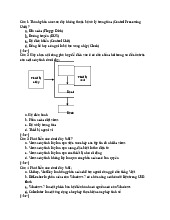



Preview text:
II. Background of FedEx
FedEx Express is one of the world's fastest delivery companies, providing fast and reliable
delivery services to more than 220 countries and territories. FedEx Express uses a global air
and ground network to speed shipments that need to be delivered quickly at a speci 昀椀 c date and time. FedEx of Vietnamese: DESCRIBE:
The world's largest express delivery company
PRESTIGE EXPRESS DELIVERY ACTIVITIES: 1994 PRESTIGIOUS GOODS 1994 TRANSPORTATION ACTIVITIES: LOCAL HEADQUARTERS: 6-storey building,
39B Truong Son Street, Ward 4, Tan Binh District, Ho Chi Minh City, Vietnam MAIN OPERATOR:
Ee-Hui Tan, Managing Director of
FedEx Express Vietnam and FedEx Express Cambodia STAFF: About 650 employees COUNTRIES AVAILABLE:
Over 220 countries and territories AIRPORTS WITH SERVICES:
Tan Son Nhat International Airport, Noi Bai International Airport FLEET: 201 vehicles RECEIPT BOX LOCATION: 1 representative o 昀케 ce 2 stations 12 world service centers AIRCRAFT USED: B767 WEB ADDRESS: http://www.fedex.com/vn
FedEx of Asia Paci 昀椀 c, Middle East and Africa: TRANSPORTATION ACTIVITIES: 1984 in Asia Paci 昀椀 c 1989 in the Middle East
1997 in India (previously through GSP)
2014 in South Africa (previously through GSP)
2019 in Oman (previously through GSP)
2020 in Kenya (previously through GSP)
2021 in Saudi Arabia, Indonesia, Jordan
and Egypt (previously through GSP) 2022 in Cambodia, Nigeria (previously through GSP) HEADQUARTERS: Singapore SUB-REGIONAL HEADQUARTERS:
Mainland China – Shanghai, China
North Paci 昀椀 c – Tokyo, Japan Southeast Asia – Singapore
Australasia – Sydney, Australia
Middle East, India and Africa – Mumbai, India AMEA REGION KEY OPERATORS:
Kawal Preet, Regional President STAFF: About 35,000 AMEA REGIONAL CENTER:
Guangzhou Baiyun International Airport, Guangzhou, China
Kansai International Airport, Osaka, Japan Changi International Airport, Singapore Pudong International Airport, Shanghai, China
Dubai International Airport, Dubai, United Arab Emirates.
COUNTRIES & REGIONS WHERE SERVICES 100 ARE AVAILABLE: AIRCRAFT USED: B767F, B777F và MD-11 FLEET: About 9,000
1. Founding and Early Years: •
Establishment: FedEx was founded in 1971 by Frederick W. Smith in Memphis, Tennessee, USA. •
Founding Vision: Frederick W. Smith envisioned a system that could provide
overnight shipping for time-sensitive deliveries.
2. Innovation and Business Model: •
Air Cargo Hub: FedEx pioneered the use of a centralized air cargo hub, allowing for
more e 昀케 cient sorting and quick deliveries. •
Overnight Shipping: The introduction of the overnight shipping concept
revolutionized the transportation industry. 3. Global Expansion: •
International Presence: FedEx rapidly expanded its services globally, establishing a
substantial international presence. •
Strategic Acquisitions: The company strategically acquired other logistics and
transportation companies to enhance its global reach. 4. Diverse Services: •
Express Delivery: FedEx is renowned for its express delivery services, ensuring fast and reliable shipments. •
Supply Chain Solutions: In addition to shipping, FedEx provides a range of supply
chain solutions, including logistics and warehousing.
5. Technological Advancements: •
Digital Integration: FedEx embraced technology, implementing digital solutions for
tracking, real-time updates, and e 昀케 cient management. •
Mobile Accessibility: The company o 昀昀 ers mobile applications for users to track
shipments and manage logistics on the go.
6. Corporate Responsibility: •
Community Engagement: FedEx actively engages in corporate social responsibility,
contributing to communities and participating in disaster relief e 昀昀 orts. •
Sustainability E 昀昀 orts: The company has undertaken sustainability initiatives to
reduce its environmental impact.
7. Challenges and Adaptations: •
Global Challenges: FedEx faces challenges such as 昀氀 uctuating fuel prices, global
economic conditions, and the evolving nature of the logistics industry. •
Adaptations: The company continually adapts to technological advancements and
market changes to maintain its competitive edge.
III. Overview of FedEx information system
1. Order Management System (OMS): OMS helps manage and track customer orders
from initiation to delivery. It includes functionalities for order processing, inventory
management, and order ful 昀椀 llment.
2. Warehouse Management System (WMS): WMS is crucial for logistics companies in
managing and optimizing warehouse operations. It involves inventory tracking, order
picking, packing, and shipping.
3. Transportation Management System (TMS): TMS assists in planning, execution, and
optimization of the physical movement of goods. It includes route planning, carrier
selection, and freight audit capabilities.
4. Enterprise Resource Planning (ERP): ERP systems integrate various business
processes, including 昀椀 nance, human resources, and supply chain management.
They provide a centralized database and streamline communication between di 昀 昀 erent departments.
5. Customer Relationship Management (CRM): CRM systems help in managing
interactions with customers. For FedEx, this includes tracking shipments, handling
customer inquiries, and providing realtime updates.
6. Business Intelligence (BI): BI tools analyze and present data to support decision-
making. For FedEx, BI systems might be used to gain insights into operational e 昀
케 ciency, route optimization, and customer behavior.
7. Mobile Applications: Given the nature of the logistics industry, mobile apps play a
crucial role. They enable package tracking, driver communication, and real-time updates for customers.
8. Global Positioning System (GPS): GPS technology is integrated into logistics systems
for real-time tracking of shipments and optimizing transportation routes.
9. Electronic Data Interchange (EDI): EDI facilitates the electronic exchange of business
documents between di 昀昀 erent companies. It's commonly used in the logistics
industry for order processing and invoicing.
10. Security Systems: With the importance of secure and timely deliveries, information
systems include security features to protect sensitive data, both in transit and in storage.




